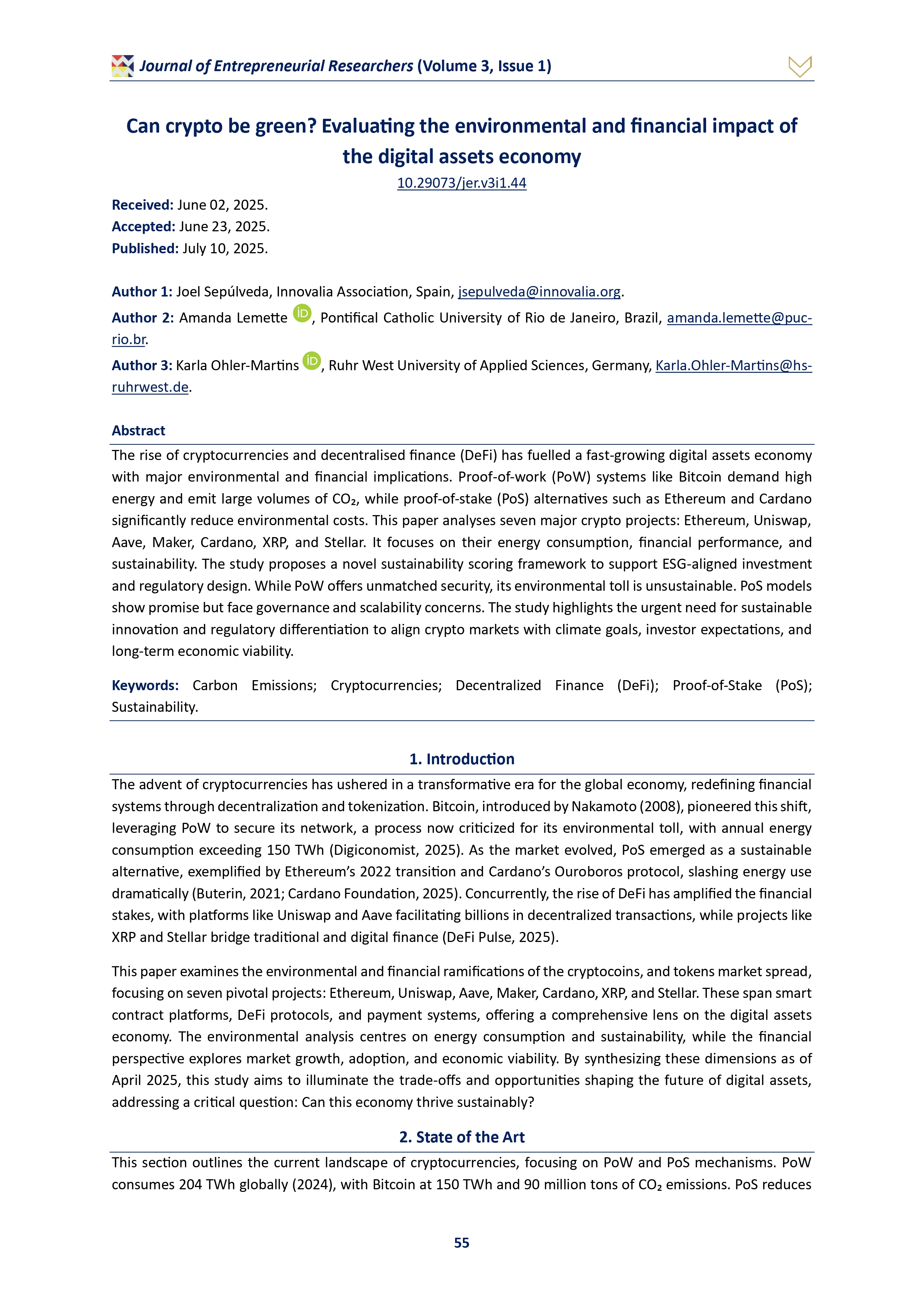Can crypto be green? Evaluating the environmental and financial impact of the digital assets economy
DOI:
https://doi.org/10.29073/jer.v3i1.44Keywords:
Carbon Emissions, Cryptocurrencies, Decentralized Finance (DeFi), Proof-of-Stake (PoS), SustainabilityAbstract
The rise of cryptocurrencies and decentralised finance (DeFi) has fuelled a fast-growing digital assets economy with major environmental and financial implications. Proof-of-work (PoW) systems like Bitcoin demand high energy and emit large volumes of CO₂, while proof-of-stake (PoS) alternatives such as Ethereum and Cardano significantly reduce environmental costs. This paper analyses seven major crypto projects: Ethereum, Uniswap, Aave, Maker, Cardano, XRP, and Stellar. It focuses on their energy consumption, financial performance, and sustainability. The study proposes a novel sustainability scoring framework to support ESG-aligned investment and regulatory design. While PoW offers unmatched security, its environmental toll is unsustainable. PoS models show promise but face governance and scalability concerns. The study highlights the urgent need for sustainable innovation and regulatory differentiation to align crypto markets with climate goals, investor expectations, and long-term economic viability.
Downloads
References
Ali Hakimi, Pazuki, M.-M., & Amidpour, M. (2024). Renewable energy and cryptocurrency: A dual approach to economic viability and environmental sustainability. Heliyon. https://doi.org/10.1016/j.heliyon.2024.e39765
Buterin, V. (2014). A next-generation smart contract and decentralized application platform (White paper).
Buterin, V. (2021, December 2). The Merge: Ethereum’s transition to proof-of-stake. Ethereum Blog. https://blog.ethereum.org/2021/12/02/the-merge
Cambridge Bitcoin Electricity Consumption Index. (2023). Cambridge Bitcoin Electricity Consumption Index. https://ccaf.io/cbeci
Cardano Foundation. (2025). Ouroboros: Energy efficiency report.
Catalini, C., & Gans, J. S. (2019). Some simple economics of the blockchain. Rotman School of Management Working Paper No. 2874598; MIT Sloan Research Paper No. 5191-16. https://doi.org/10.2139/ssrn.2874598
Chainalysis. (2025). Crypto crime report 2025.
CoinMarketCap. (2025). Cryptocurrency market capitalization. https://coinmarketcap.com
Crypto Carbon Ratings Institute. (2024). Cryptocurrency energy consumption index. CCRI.
de Vries, A. (2018). Bitcoin’s growing energy problem. Joule, 2(5), 801–805. https://doi.org/10.1016/j.joule.2018.04.016
de Vries, A., & Stoll, C. (2021). Bitcoin's growing e-waste problem. Resources, Conservation and Recycling, 175, 105901. https://doi.org/10.1016/j.resconrec.2021.105901
DeFi Pulse. (2025). Total value locked in DeFi. https://defipulse.com
Digiconomist. (2025). Bitcoin energy consumption index. https://digiconomist.net
European Commission. (2024). Markets in Crypto-Assets (MiCA) regulation.
EU ETS. (2023). Carbon price trends. https://ember-climate.org
Forbes. (2025, March). XRP price surge: Market insights.
Gómez-Martínez, R., & Medrano-Garcia, M. L. (2025, April). AI technology for developing Bitcoin investment strategies based on altcoin trends. Sustainable Technology and Entrepreneurship, 4(1), 100087.
Goodell, G., Sedlmeir, J., & Platt, M. (2023). Security vulnerabilities in proof-of-stake blockchain protocols. Science, 380(6648), 921–927. https://doi.org/10.1126/science.adf1234
Grassi, L., & Lanfranchi, D. (2022). RegTech in public and private sectors: The nexus between data, technology and regulation. Journal of Industrial and Business Economics, 49, 441–479. https://doi.org/10.1007/s40812-022-00226-0
Drăgan, G. B., Ben Arfi, W., Tiberius, V., Ammari, A., & Khvatova, T. (2024). Navigating the green wave: Understanding behavioral antecedents of sustainable cryptocurrency investment. Technological Forecasting and Social Change. https://doi.org/10.1016/j.techfore.2024.123909
Hoskinson, C. (2020, September 28). Cardano roadmap: The Alonzo era. IOHK Blog. https://iohk.io/en/blog/posts/2020/09/28/the-alonzo-era
International Monetary Fund. (2021). Carbon taxation and crypto assets. https://doi.org/10.5089/9781513574465.001
Journal of Sustainable Finance. (2022). ESG screening and cryptocurrency valuations: Institutional investor trends. Journal of Sustainable Finance & Investment, 12(3), 456–472. https://doi.org/10.1080/20430795.2022.1234567
Joule. (2021). Bitcoin’s growing energy problem. https://doi.org/10.1016/j.joule.2021.07.011
Kiayias, A., Russell, A., David, B., & Oliynykov, R. (2017). Ouroboros: A provably secure proof-of-stake blockchain protocol. In Proceedings of the 37th Annual International Cryptology Conference (pp. 357–388). Springer.
Krause, D. (2025). Regulatory clarity and XRP: The path to global institutional stablecoin adoption. https://doi.org/10.13140/RG.2.2.24441.38244
Krause, M. J., & Tolaymat, T. (2018). Quantification of energy and carbon costs for mining cryptocurrencies. Nature Sustainability, 1(11), 711–718. https://doi.org/10.1038/s41893-018-0152-7
Nakamoto, S. (2008). Bitcoin: A peer-to-peer electronic cash system. https://bitcoin.org/bitcoin.pdf
Nature Energy. (2022). Cryptocurrency mining and local energy markets. https://doi.org/10.1038/s41560-022-01027-4
Ripple. (2025). XRP Ledger sustainability report.
Saleh, F. (2021). Blockchain without waste: Proof-of-stake. Review of Financial Studies, 34(3), 1150–1174. https://doi.org/10.1093/rfs/hhaa075
Schär, F. (2021). Decentralized finance: On blockchain — and smart contract-based financial markets. Federal Reserve Bank of St. Louis Review, 103(2), 153–174. https://doi.org/10.20955/r.103.153-74
Schwartz, D., Youngs, N., & Britto, A. (2014). The Ripple protocol consensus algorithm. Ripple Labs.
Sedlmeir, J., Buhl, H. U., Fridgen, G., & Keller, R. (2020). The energy consumption of blockchain technology: Beyond myth. Business & Information Systems Engineering, 62(6), 599–608. https://doi.org/10.1007/s12599-020-00656-x
Sedlmeir, J., Buhl, H. U., & Fridgen, G. (2022). Carbon pricing for proof-of-work blockchains: Addressing environmental externalities. Nature Energy, 7(10), 987–995. https://doi.org/10.1038/s41560-022-01123-4
Seungju, L., Jaewook, L., & Woojin, L. (2025). Interconnected dynamics of sustainable cryptocurrencies: Insights from transfer entropy analysis. Finance Research Letters. https://doi.org/10.1016/j.frl.2025.106914
Solana Labs. (2025). Solana network performance metrics.
Stellar Development Foundation. (2025). Stellar consensus protocol overview.
Swan, M. (2020). Blockchain economics: Implications of distributed ledgers. World Scientific Publishing.
Syamsul, R., & Kim Dong, S. (2025). Enhancing blockchain consensus mechanisms: A comprehensive survey on machine learning applications and optimizations. Blockchain Research and Applications. https://doi.org/10.1016/j.bcra.2025.100302
Tapscott, D., & Tapscott, A. (2016). Blockchain revolution: How the technology behind Bitcoin is changing money, business, and the world. Penguin.
Truby, J. (2018). Decarbonizing Bitcoin: Law and policy choices for reducing the energy consumption of blockchain technologies and digital currencies. Energy Research & Social Science, 44, 399–410. https://doi.org/10.1016/j.erss.2018.06.009
Wood, G. (2021). Cardano: A sustainable blockchain. IOHK.
World Economic Forum. (2020). Crypto, what is it good for? An overview of cryptocurrency use cases. Global Future Council on Cryptocurrencies. https://www3.weforum.org/docs/WEF_Cryptocurrency_Uses_Cases_2020.pdf
Yakovenko, A. (2018). Solana: A new architecture for a high-performance blockchain. Solana Whitepaper.

Downloads
Published
How to Cite
Issue
Section
License
Copyright (c) 2025 Journal of Entrepreneurial Researchers

This work is licensed under a Creative Commons Attribution 4.0 International License.






